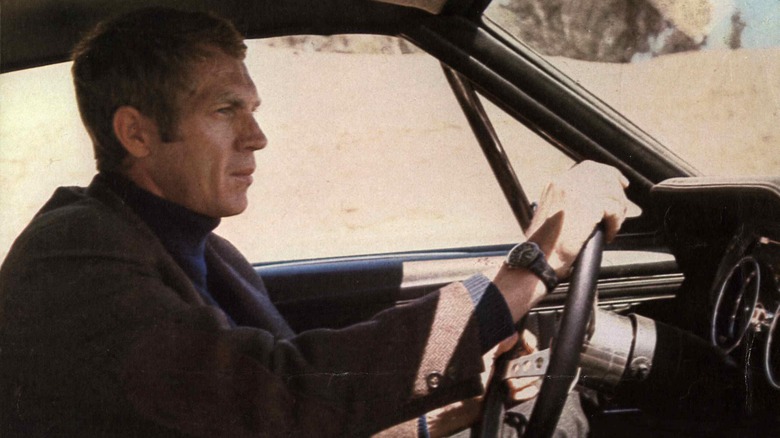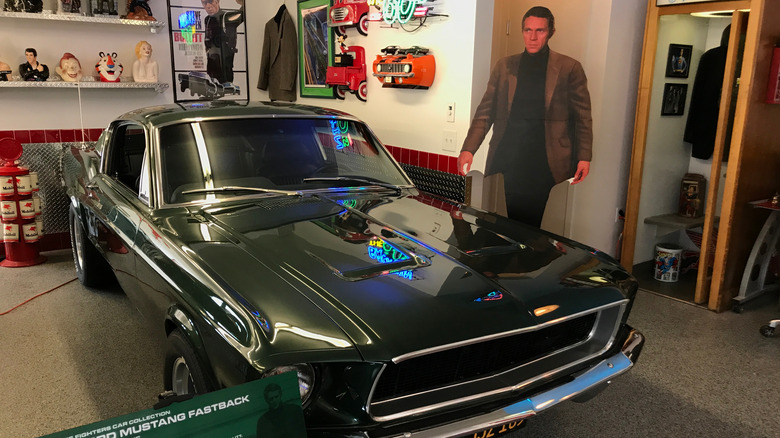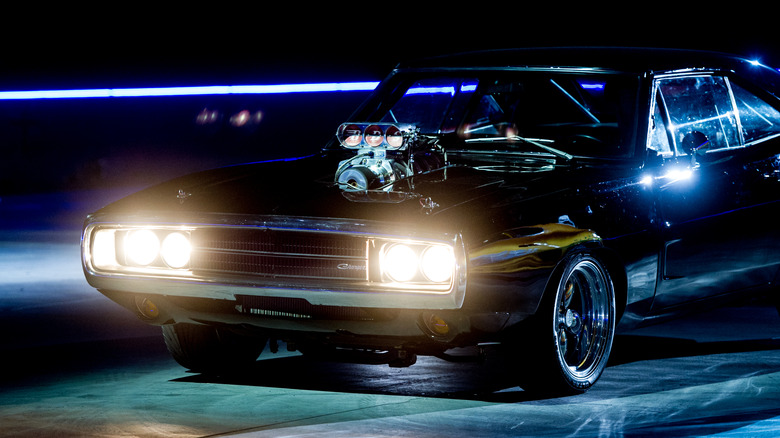How The 1968 Film, Bullitt, Made Fast And Furious Possible
"Bullitt" has been synonymous with car chases, but how did a film that didn't even revolve around racing help elevate a genre that the "Fast and Furious" franchise popularized today? Instead of drawing inspiration from illicit street racing, the 1968 crime drama "Bullitt" was based on Robert Fish's novel "Mute Witness." It starred the titular character and promising SFPD detective Frank Bullitt, played by celebrated actor Steve McQueen. Its plot involved Bullitt getting himself entangled in a dangerous cat-and-mouse game against a shadowy underworld organization threatening to ruin his career.
Now, aside from the actors, the film also starred a couple of inanimate icons as well, namely Bullitt's legendary Ford Mustang and his adversary's equally-famous '68 Dodge Charger, both of which were responsible for one of Hollywood's most epic car chase sequences. The "Fast and Furious" franchise, on the other hand, also featured law-fighting shady crime syndicates, but with a bigger emphasis on racing and, of course, family. While both films might share some plot commonalities, "Bullitt's" story isn't exactly how it inspired a franchise that put the Mustang Fastback back on the map. For that, let's go back to how the film made waves among car enthusiasts and action film aficionados alike in the first place.
Pioneering the most epic car chase of all time
Prior to the "Fast and Furious" films, "Bullitt" showcased what many believe is arguably the most iconic car chase in movie history. What made it special was how it was presented, which was a very raw portrayal, something that was quite unprecedented at the time. In Car Insider's Snapchat — which compiled the 100-year history of Hollywood's car chase sequences — it showed how rudimentary these scenes used to be. Starting with the 1924 film "Sherlock Jr.," chases were only as basic as filmmakers shooting the sequence backward before playing it in reverse to emulate the notion of danger and speed. Filming equipment limitations prevented older movies from portraying real car stunts on actual streets.
That is, until "Bullitt" came into the picture, bringing with it a pretty realistic, over-10-minute-long car chase scene that's as thrilling as it is authentic. This is thanks to advancements in filming equipment. Since the film utilized more durable and compact cameras — such as the Arriflex 35 II — its filmmakers were able to shoot car chases in real locations instead of a movie set. This allowed "Bullitt" to capture stunts on San Francisco's hills while putting audiences in the seat of the action with its in-car shots courtesy of portable cameras. The film editing in "Bullitt" was so exceptional, it won an Academy Award in 1969 (via Oscars). However, better gear is just one part of how "Bullitt" set the standard for car chase scenes to come.
Authenticity makes the best car stunts
The desire of "Bullitt" and its filmmakers to keep everything as authentic as possible certainly inspired future generations of films. From filming in actual locations and buildings around San Francisco to using real doctors in hospital scenes, the film aspired to make viewers feel the authenticity of its setting (via Hagerty). Although its filmmakers alone were able to capture just that, actor McQueen himself also exuded this air of gritty realism that further enhanced it. In an interview with Jalopnik, McQueen's body double Loren Janes claimed the actor wanted his stunts done as realistically as possible.
This sense of realism translated to "Bullitt's" epic car chase scene which was done over the course of four weeks. Janes claimed the whole sequence had to be perfectly choreographed by expert stunt coordinators. Director Peter Yates tied cameras to the cars themselves for added immersion, while Janes and the Dodge Charger's stunt driver Bill Hickman pushed them to the limit. Then there are the cars themselves, which Loren explained "weren't ordinary cars." Instead, they were modified using overinflated tires and reinforced racing parts as they needed to be faster than street cars yet durable enough to endure enough punishment for various stunt maneuvers. The "Bullitt" stunt crew had to master their cars; knowing when to push the throttle, hit the brakes, and determine which specific part to crash in certain scenes to capture the perfect car chase.
Fast-forwarding the 'Fast and Furious' generation
It's hard to argue with the results of "Bullitt's" masterful car chase sequence, especially when it set the bar that succeeding films have been trying to surpass. "Bullitt" not only pushed the envelope of car chase scenes moving forward, but it also inspired "Fast and Furious" stars like Sung Kang. Aside from the "Fast" series reviving the film's classic icons — like the Mustang and Charger — it also tried to up the ante using similar techniques. This includes modifying cars for stunts, equipping multiple cameras onto special car rigs, and going to great lengths for short chase scenes that barely take up the film's total screen time.
The most epic car chase of all time only took about 10 minutes of "Bullitt's" almost two-hour runtime, yet it still took several weeks to prepare. Likewise, "F9" exerted similar effort when preparing for eight months on a scene that only lasted only four seconds (via Insider). According to the film's advisor Craig Lieberman, many of the series' car stunts were just as risky, requiring actual reproduction in real life, with stakes that are just as high. The long-running franchise now serves as the culmination of decades of technological progress in regard to filmmaking and car chases. To think it all started from a crime drama that just happened to include one of the best car chases in movie history.


